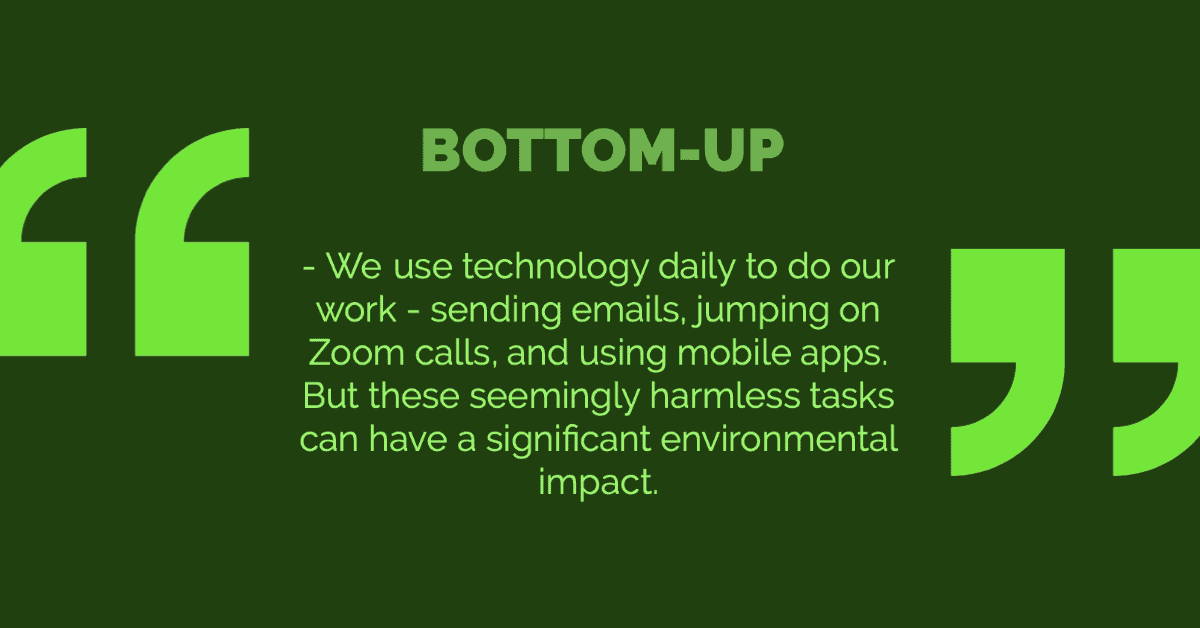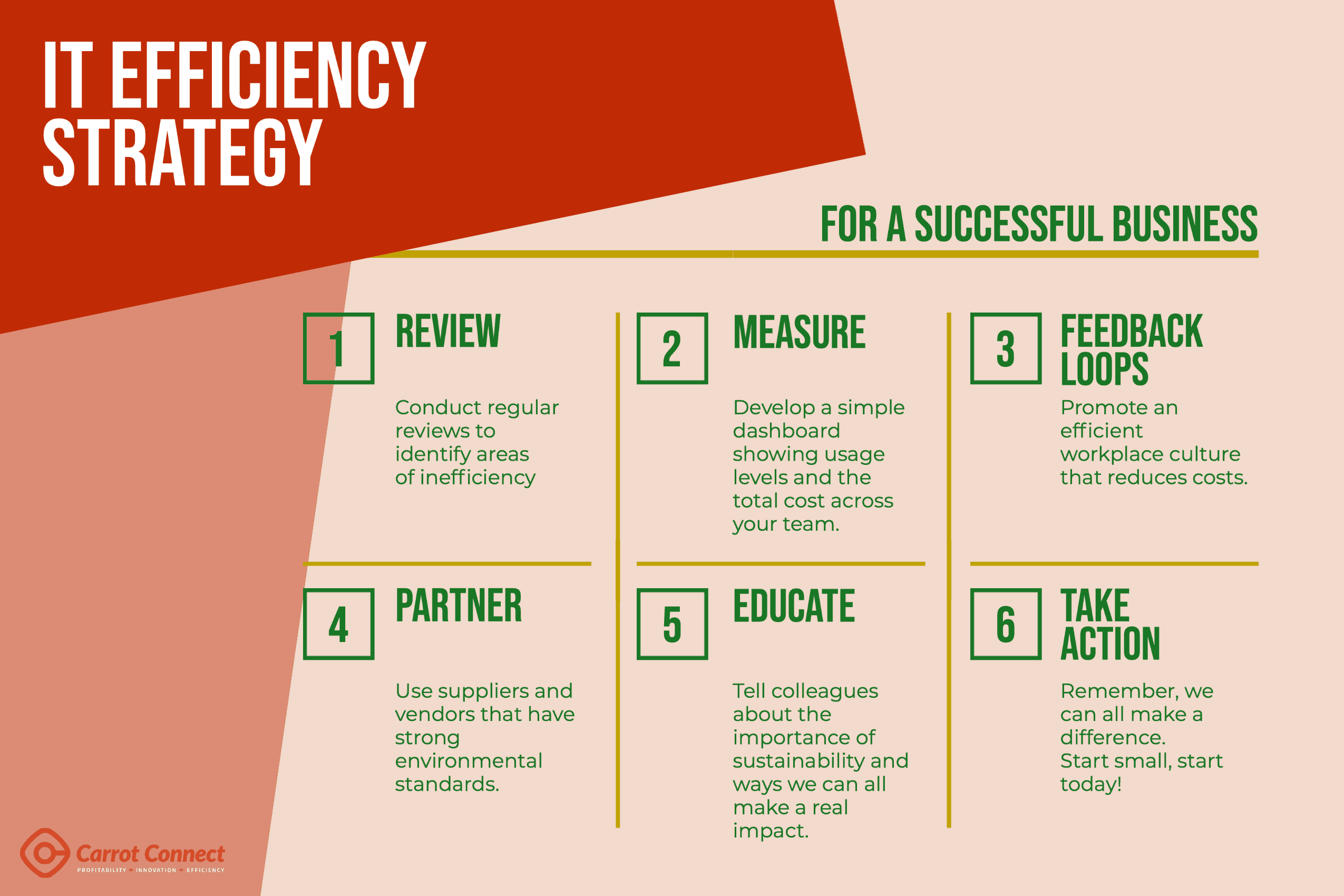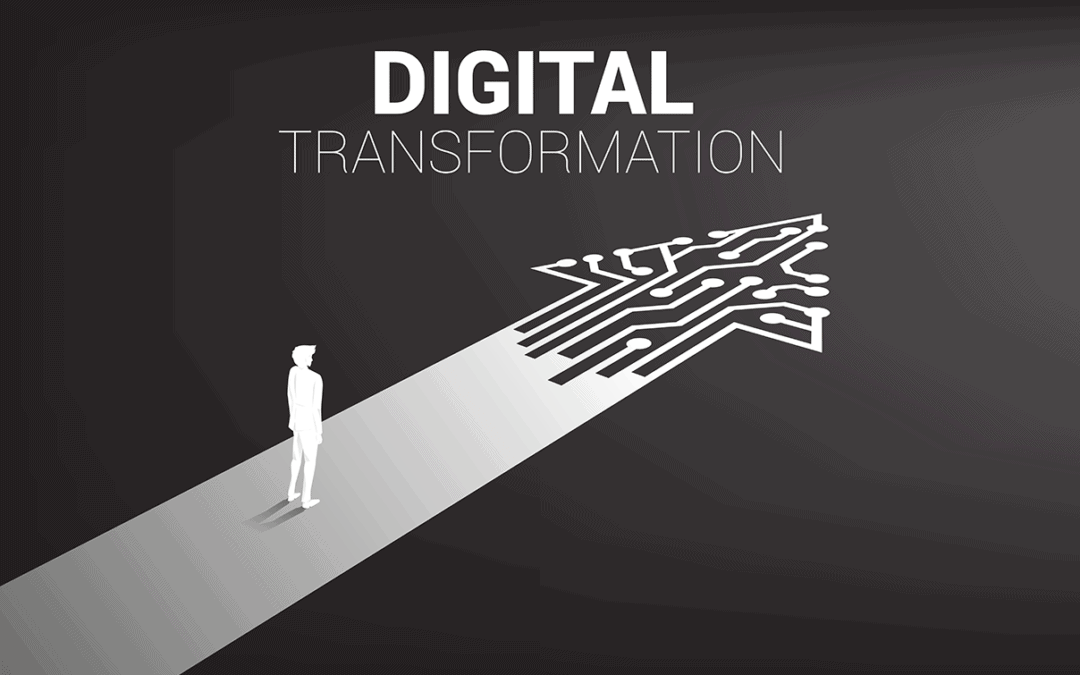Introduction
Eight years ago, I wrote an article highlighting email’s negative impacts on my productivity levels.
By analysing my inbox data, I estimated that email consumed 20% of my time at work. This insight drove me to change my practices and become more efficient. However, I hadn’t considered this daily activity’s actual cost and environmental ramifications, which still consumes many.
In this article, I will examine how email and other everyday tasks can have an enormous environmental effect and offer easy ways to diminish them. By collectively understanding how we work, we can reduce costs while positively impacting sustainability.
Contents
PART I
1. A Bottom-Up Approach to IT Sustainability
Companies are becoming ever more conscious of the environmental impact of their operations. As such, sustainability practices and green initiatives have become increasingly popular among businesses, with many boards setting company ESG metrics and driving change from the top down.
While sustainable developments often focus on external benefits, internal opportunities exist to reduce workplace inefficiencies and contribute towards a more sustainable future. By engaging everyone at all levels within an organisation, tangible steps can be taken for meaningful progress towards reducing environmental impact.
IT tasks are a prime example of these hidden business costs. We use technology daily to do our work – sending emails, jumping on Zoom calls, and using mobile apps. But these seemingly harmless tasks can have a significant environmental impact.
What’s more, these impacts are often hidden from view, and the indirect business costs incurred are easy to overlook but can affect a company’s bottom line. Research shows that businesses could significantly save money yearly by making their business processes more efficient.
Thinking through our everyday activities with an eye toward sustainable practices can unearth surprising environmental costs. Our seemingly innocuous habits may have a more significant impact than we expect – let’s examine the most routine tasks.

2. Email
Back in 2015, when I wrote my original post, I received, on average, 70 emails a day.
Last year, statistics suggested the average person gets between 60 and 120 emails per day. If we take the midpoint between the research, that’s 90 per day. What is clear is that the volume of emails we receive is still an issue, and I’m sure this is just the tip of the iceberg for many reading this!
Now, let’s evaluate the greenhouse gas emissions of these emails.
Mike Berners-Lee’s excellent publication “How Bad Are Bananas” found that an average email emits approximately 4 grams of Carbon Dioxide equivalent (CO2e). However: if an email takes you ten minutes to write and three seconds or more to read, you’ll produce 17g of CO2e. Further, if you add one image or attachment, this jumps to 50g CO2e!
Everyone receives emails of varying complexity, from short to those with attachments. For illustration purposes, let’s assume the resulting averages are 10g CO2e per email. Since most of us typically get 90 emails daily, that amounts to 900g of CO2e in terms of our overall email carbon footprint.
But so what, I hear you say.
In context, this is the same as boiling a kettle 13 times or driving an average family car 5 kilometres (or 15 Km for an electric vehicle) around town.
Of course, many aspects play a role in quantifying carbon emissions, but I’m sure you get the point: More emails result in more CO2e and reduced sustainability.
Question: How many emails are you cc’d on that do nothing but take up your time?
3. Video Calls
The repercussions of the global pandemic have caused an exponential rise in video calls as we have all adapted to a remote and hybrid working lifestyle. Zoom, Teams, and Google Meet, amongst others, have become part of our daily lives.
But did you know a sixty-minute video call between two people consumes more energy than keeping an average laptop running for one day?
Specifically, if you hold a meeting in HD quality – the estimated carbon footprint is 3.7g of CO2e. However, as most of us typically use Full HD (aka 1080p – which employs about double the number of pixels), our emissions skyrocket fourfold – to 14.8g of CO2e.
Put another way, that sixty minute video call is the same as receiving 63 emails or boiling a kettle.
Intuitively, larger meetings equate to more energy consumption. A one-hour weekly team meeting with six people using Full HD (1080p) emits 50g of CO2e into the atmosphere. With many of our calendars maxed out with back to back meetings, the numbers soon mount up.
Question: How many virtual calls with co-workers have you had to sit through this week which didn’t result in any positive action?
4. Printing
The positive news about us adjusting to remote/hybrid working is that the number of documents we print has drastically reduced.
But when you do print, what is the impact of a single page using a laser printer? Numerous factors come into play: the energy efficiency of the printer, the origin of electricity, and the materials used in making the ink and paper.
However, according to estimations, printing a single page produces an average of 4g CO2e.
Question: How many reports do you print that you have never read?
5. Mobile Phones
Studies have shown that if you use your mobile for just one hour a day, your phone will emit 63 kilograms of CO2e into the atmosphere annually.
Most alarming is that the manufacturing of a mobile phone has an even larger carbon footprint than its total usage. Therefore, our desire to constantly replace our phones with newer versions produces an unfathomable amount of e-waste. In 2019, this was estimated to be around 50 million metric tons– making up 10% of the world’s total e-waste!
Not only does this amount of waste damage the environment, but it also has a human cost. The fact is that many devices are recycled in developing countries without proper safety protocols or guidelines to protect workers from hazardous materials used during the process.
Question: How often do you upgrade your phone?
6. Conversational AI
Finally, let’s take a quick look at the mindblowing conversational AI products, such as ChatGPT.
ChatGPT is a game-changing interactive AI chatbot that can fulfil many tasks. With its humanlike capabilities, you can converse with its intelligent interface as if it were another person.
Despite its incredible benefits, ChatGPT-type tech has significant impacts.
Researchers estimate ChatGPT’s daily carbon footprint to be a gigantic 23 kg CO2e, and this translates to an enormous portion of the energy consumed—as high as 2-3% of global greenhouse emissions.
There is an unseen environmental dimension to this new technology which needs to be addressed as the technology matures. Given the public focus on the green credentials of large corporate firms, its inevitable attention will soon switch to their sustainability.
Question: How many needless questions have you asked Siri or ChatGPT to see what crazy results it comes up with?
PART II

1.Ways to improve efficiency in the workplace
As we’ve seen, our daily tasks can enormously impact sustainability and result in unseen environmental damage.
As organisations increasingly rely on technology to stay connected and productive, pursuing a sustainable approach is becoming increasingly important. As leaders, we can make a difference by following these simple steps.
-
- Conduct regular audits to identify and address inefficiency in operations and processes.
- We manage what we measure. Develop a simple dashboard showing usage levels and the total cost across your team.
- Build feedback loops to promote an efficient workplace culture that eliminates needless activity and reduces costs.
- Partner with suppliers and vendors that have strong environmental standards.
- Educate colleagues on the importance of sustainability and ways we can all make a real impact in our personal and professional lives.
2. Some personal quick win tips
- Only keep the most important of emails, as storing them uses power. A red flag if you have a large inbox.
- Routinely empty your deleted folder.
- Consider how many people you send an email to. Can you reduce the number of people you copy into your email?
- When possible, resort to audio-only on video calls or lower your video quality.
- Consider attendees when setting up a video call. Will there be a decision-maker to move things forwards? Does everyone need to be present?
- Can you print your document in black and white and use both sides of the paper?
- But first, ask yourself, do you need to print it?
- When using tools like ChatGPT, think about the question you’re going to ask in advance to reduce the number of queries you need to run.
- Wherever possible, opt for a laptop instead of a desktop, as they generally use less power while performing the same tasks.
- Encourage your team to switch off devices overnight rather than leaving them on standby mode – this will further reduce your energy consumption.
In the long run, it’s essential to consider how our actions today may affect the future. Making small changes in our habits can go a long way towards sustainability!
3. Is remote working better for the environment than working in an office?
Finally, whilst writing this post, I was intrigued to find out which working model is considered the most environmentally friendly – in the office or remote.
Finding the answer to this question is challenging, as various complex permutations must be thoughtfully assessed.
Remote working can have environmental benefits by reducing transportation-related emissions, as we do not need to commute to the office. This can lead to a reduction in air pollution and greenhouse gas emissions. Additionally, remote working can lead to energy savings in the office, as less lighting and equipment is powered on.
However, remote working also has its own set of environmental challenges. For example, we may use more energy at home to power our computers and other equipment. Additionally, this can lead to increased online shopping and food delivery, resulting in more waste and pollution.
Overall, it’s essential to consider all of our activities, whether working at home or in the office. It can be difficult to assess the ecological effects. However, as we’ve seen, we can take steps to reduced the volume of our mundane tasks and mitigate the unseen negative impacts.
Conclusion
IT sustainability is an increasingly important key performance indicator for sustainable business, becoming integral to many operations. However, sustainability doesn’t need to be complex.
Ultimately, through making a conscious effort to reduce inefficiency, unnecessary wastage and emissions generated from daily IT tasks can be decreased drastically. Organisations must take steps towards reducing their corporate footprints while continuing to deliver optimal results.
Achieving maximum impact requires a comprehensive strategy that harnesses both top-down and bottom-up approaches. In this post, we outlined accessible practices everyone can do to make an effective contribution – no matter how small. Our efforts all add up, and creating sustainable workplaces will generate positive economic impacts that result in cost savings.
Climate change is an ever-looming reminder of our responsibility to safeguard the planet and its precious natural resources. Striving for sustainability now will help ensure that future generations can continue benefiting from a healthy natural environment.
Together, our actions have the power to create a lasting positive influence

PART III
IT ESG
Conversational AI
Conversational AI is artificial intelligence technology that enables machines to interact with humans in natural language. It uses natural language processing (NLP) to capture user intent and speech recognition software to understand spoken commands.
This technology can be used in automated customer service centres, virtual assistants, chatbots, and other applications where computers need to respond to human queries quickly and accurately. It aims to provide a seamless and intuitive user experience by understanding their intent, interpreting their requests, and responding appropriately.
ChatGPT
ChatGPT is a conversational AI technology developed by OpenAI. It is a deep learning-based natural language processing (NLP) system designed to enable machines to interact with humans in a more human-like way.
ChatGPT can be used to create virtual assistants, chatbots, and other interactive applications.
CO2e
“Carbon dioxide equivalent” is a term for describing different greenhouse gases in a standard unit. For any quantity and type of greenhouse gas, CO2e signifies the amount of CO2 which would have the equivalent global warming impact.
Frequently asked questions
What is IT ESG purpose?
With an understanding of IT ESG, we can explore alternative, more ethical computing models like shared or distributed resources. This can optimise the way services are delivered and even improve plans for scalability for our businesses. Overall, applying IT ESG allows us to operationalise sustainability and perform day-to-day IT operations with positive environmental outcomes
Is ESG sustainable?
While ESG can be a valuable tool for identifying companies making positive contributions to sustainability, it’s important to note that it is not a perfect measure of sustainability.
One limitation of ESG is that it can be challenging to define and measure. Different organisations and investors may have different definitions of what constitutes good ESG performance, making it difficult to compare companies’ ESG performance against one another. Additionally, some companies may use greenwashing techniques to present a better ESG performance than they have.
Another area for improvement of ESG is that it can be costly for companies to implement. Adopting sustainable practices and investing in socially responsible initiatives can be expensive, and some companies may need help. This could put these companies at a disadvantage compared to their peers with more resources.
Additionally, some argue that focusing too much on ESG could lead to neglecting other vital aspects of a company’s performance and operations. For example, companies may focus so much on environmental sustainability that they overlook other critical areas, such as financial performance.
It’s also worth noting that the ESG criteria are not a guarantee of sustainability but rather a tool for identifying companies making a positive impact. Therefore, it’s essential to consider a company’s overall sustainability performance and not just its ESG scores.
In summary, ESG can be a valuable tool for identifying companies making positive contributions to sustainability. Still, it’s essential to be aware of its limitations and to consider a company’s overall sustainability performance.
What is the downside of ESG?
While many investors and companies see ESG as a positive development supporting economic growth, there are also some downsides.
One downside of ESG is that it can take time to define and measure. Different organisations and investors may have different definitions of what constitutes good ESG performance, and it can be challenging to compare companies’ ESG performance against one another. Additionally, some companies may use greenwashing techniques to present a better ESG performance than they have.
Another downside of ESG is that it can be costly for companies to implement. Adopting sustainable practices and investing in socially responsible initiatives can be expensive, and some companies may need help. This could put these companies at a disadvantage compared to their peers with more resources.
Additionally, some argue that focusing too much on ESG could lead to neglecting other vital aspects of a company’s performance and operations. For example, companies may focus so much on environmental concerns that they overlook other critical areas, such as financial performance.
Finally, some argue that the ESG criteria may discourage companies from investing in certain regions, industries or projects that could benefit the local economy but that may not be considered sustainable from an ESG perspective.
In summary, ESG is a complex issue, and while it can have a positive impact, it’s essential to consider the potential downsides and trade-offs.
What are the three essential pillars of ESG?
- Environmental: This pillar refers to a company’s environmental impacts, including greenhouse gases, water usage, water pollution, and reduced waste management. Companies that score well on the ecological part of ESG tend to have strong environmental policies and processes and may also invest in renewable energy, clean energy and other sustainable technologies (such as wind turbines).
- Social: This pillar refers to a company’s impact on society, including labour practices, human rights, and community engagement. Companies that score well on the social post of ESG tend to have solid policies and processes to promote diversity, inclusion, and fair treatment of employees. They may also invest in community development and other socially responsible initiatives.
- Governance: This pillar refers to a company’s management and leadership, including transparency, accountability, and ethical behaviour. Companies that score well on the governance pillar of ESG tend to have strong corporate governance practices, including effective oversight by the board of directors. They may also have a solid commitment to ethical behaviour and transparency in their operations.
It’s important to note that different organisations and investors may have other criteria and weightings for these three pillars. Some ESG frameworks may include additional areas such as debt and liquidity, supply chain management and product stewardship.
Do ESG funds underperform?
The performance of ESG funds can vary, and whether they underperform compared to traditional funds is a topic of debate in the investment community. Some studies have found that ESG funds have performed as well or better than conventional funds, while others have found that they have underperformed.
A few studies have shown positive results of ESG funds which have outperformed traditional funds over the long term. For example, a 2020 study by MSCI found that over the past ten years, companies with high ESG ratings outperformed those with low ESG ratings by 2.5% per year, on average. Another study from 2020 by Morningstar found that, on average, the returns of sustainable funds were like those of traditional funds over the past five years.
However, other studies have found the value of ESG funds which have underperformed traditional funds. For example, a 2020 CFA Institute study found that ESG funds had lower returns over five years than conventional funds. Additionally, an S&P Dow Jones Indices study found that ESG funds had slightly lower returns over ten years than traditional funds.
It’s also worth noting that some of the studies showing the underperformance of ESG funds are based on small sample sizes and may not represent the overall market.
References
Greenhouse Gases, CO2, CO2e, and Carbon: What Do All These Terms Mean? (Unknown). In Ecometrica.
What’s the carbon footprint of an email? (Unknown). In Paw Print Eco Companion.
Did You Know Deleting Old Emails Helps The Planet (2022, February 23). In remoov.
Energy Efficient Kettles – Everything You Should Know (2022, June 21). In beec.
How our daily travel harms the planet (2020,March 18). In BBC.
The Hidden Pollution Cost of Online Meetings (2020, March 9). In CMSWIRE.
ezeep is Committed to Carbon-Neutral Printing (Unknown). In ezeep.
How smartphones are contributing to climate change (2022, February 2). In infomineo.
The Carbon Footprint of ChatGPT (2022, December 21). In Towards Data Science.






